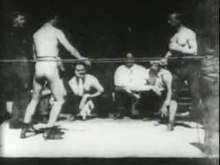Marquess of Queensberry rules (1867)
In 1867, the Marquess of Queensberry rules were drafted by John Chambers for amateur championships held at Lillie Bridge in London for Lightweights, Middleweightsand Heavyweights. The rules were published under the patronage of the Marquess of Queensberry, whose name has always been associated with them.

The June 1894 Leonard–Cushing bout. Each of the six one-minute rounds recorded by the Kinetographwas made available to exhibitors for $22.50.[15] Customers who watched the final round saw Leonard score a knockdown.
There were twelve rules in all, and they specified that fights should be “a fair stand-up boxing match” in a 24-foot-square or similar ring. Rounds were three minutes with one-minute rest intervals between rounds. Each fighter was given a ten-second count if he was knocked down, and wrestling was banned. The introduction of gloves of “fair-size” also changed the nature of the bouts. An average pair of boxing gloves resembles a bloated pair of mittens and are laced up around the wrists.[16] The gloves can be used to block an opponent’s blows. As a result of their introduction, bouts became longer and more strategic with greater importance attached to defensive maneuvers such as slipping, bobbing, countering and angling. Because less defensive emphasis was placed on the use of the forearms and more on the gloves, the classical forearms outwards, torso leaning back stance of the bare knuckle boxer was modified to a more modern stance in which the torso is tilted forward and the hands are held closer to the face.
Late 19th and early 20th centuries
Through the late nineteenth century, the martial art of boxing or prizefighting was primarily a sport of dubious legitimacy. Outlawed in England and much of the United States, prizefights were often held at gambling venues and broken up by police.[17]Brawling and wrestling tactics continued, and riots at prizefights were common occurrences. Still, throughout this period, there arose some notable bare knuckle champions who developed fairly sophisticated fighting tactics.

Amateur Boxing Club, Wales 1963
The English case of R v. Coney in 1882 found that a bare-knuckle fight was an assault occasioning actual bodily harm, despite the consent of the participants. This marked the end of widespread public bare-knuckle contests in England.
The first world heavyweight champion under the Queensberry Rules was “Gentleman Jim” Corbett, who defeated John L. Sullivan in 1892 at the Pelican Athletic Club in New Orleans.[18]
The first instance of film censorship in the United States occurred in 1897 when several states banned the showing of prize fighting films from the state of Nevada,[19] where it was legal at the time.
Throughout the early twentieth century, boxers struggled to achieve legitimacy.[citation needed] They were aided by the influence of promoters like Tex Rickard and the popularity of great champions such as John L. Sullivan.
Modern Boxing
The sport rising from illegal venues and outlawed prize fighting has become one of the largest multibillion-dollar sports today. A majority of young talent still comes from poverty-stricken areas around the world. Places like Mexico, Africa, South America, and Eastern Europe prove to be filled with young aspiring athletes who wish to become the future of boxing. Even in the U.S., places like the inner cities of New York, and Chicago have given rise to promising young talent. According to Rubin, “boxing lost its appeal with the American middle class, and most of who boxes in modern America come from the streets and are street fighters“